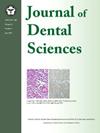Improving osteogenic properties of zirconia ceramic via glow discharge plasma-enhanced deposition of amine organic compound
IF 3.4
3区 医学
Q1 DENTISTRY, ORAL SURGERY & MEDICINE
引用次数: 0
Abstract
Background/purpose
Osseointegration potential is greatly depended on the interaction between bone cells and dental implant surface. Since zirconia ceramic has a bioinert surface, functionalization of the surface with an organic compound allylamine was conducted to overcome its drawback of minimal interaction with the surrounding bone.
Materials and methods
The zirconia surface was initially treated with argon glow discharge plasma (GDP), then combined with amine plasma at three different conditions of 50-W, 75-W and 85-W, to prepare the final samples. The surface characteristics and cell biocompatibility were then evaluated.
Results
Surface morphology analysis revealed a bulbous pattern on allylamine-treated sample groups. The aromatic C–H, C–O, N–H, C ˆ C, and C–H stretching and functional groups have been identified. Surface roughness increased, and hydrophilicity improved after surface modification. Cell viability analysis showed the highest result for the allylamine 50-W (A50) group. Alkaline phosphatase (ALP) assay indicated the A50 group had the highest activity, subsequently promoting late-stage mineralization at day 21. The reverse transcription-quantitative polymerase chain reaction (RT-qPCR) data demonstrated a significant upregulation of osteogenic gene expressions from day 1 to day 21.
Conclusion
The allylamine-treated surface demonstrates immense enhancement in the surface hydrophilicity as well as in the viability, differentiation, and osteogenic properties of osteoblast-like cells. This makes it a promising candidate for future dental implant applications.
求助全文
约1分钟内获得全文
求助全文
来源期刊

Journal of Dental Sciences
医学-牙科与口腔外科
CiteScore
5.10
自引率
14.30%
发文量
348
审稿时长
6 days
期刊介绍:
he Journal of Dental Sciences (JDS), published quarterly, is the official and open access publication of the Association for Dental Sciences of the Republic of China (ADS-ROC). The precedent journal of the JDS is the Chinese Dental Journal (CDJ) which had already been covered by MEDLINE in 1988. As the CDJ continued to prove its importance in the region, the ADS-ROC decided to move to the international community by publishing an English journal. Hence, the birth of the JDS in 2006. The JDS is indexed in the SCI Expanded since 2008. It is also indexed in Scopus, and EMCare, ScienceDirect, SIIC Data Bases.
The topics covered by the JDS include all fields of basic and clinical dentistry. Some manuscripts focusing on the study of certain endemic diseases such as dental caries and periodontal diseases in particular regions of any country as well as oral pre-cancers, oral cancers, and oral submucous fibrosis related to betel nut chewing habit are also considered for publication. Besides, the JDS also publishes articles about the efficacy of a new treatment modality on oral verrucous hyperplasia or early oral squamous cell carcinoma.
 求助内容:
求助内容: 应助结果提醒方式:
应助结果提醒方式:


